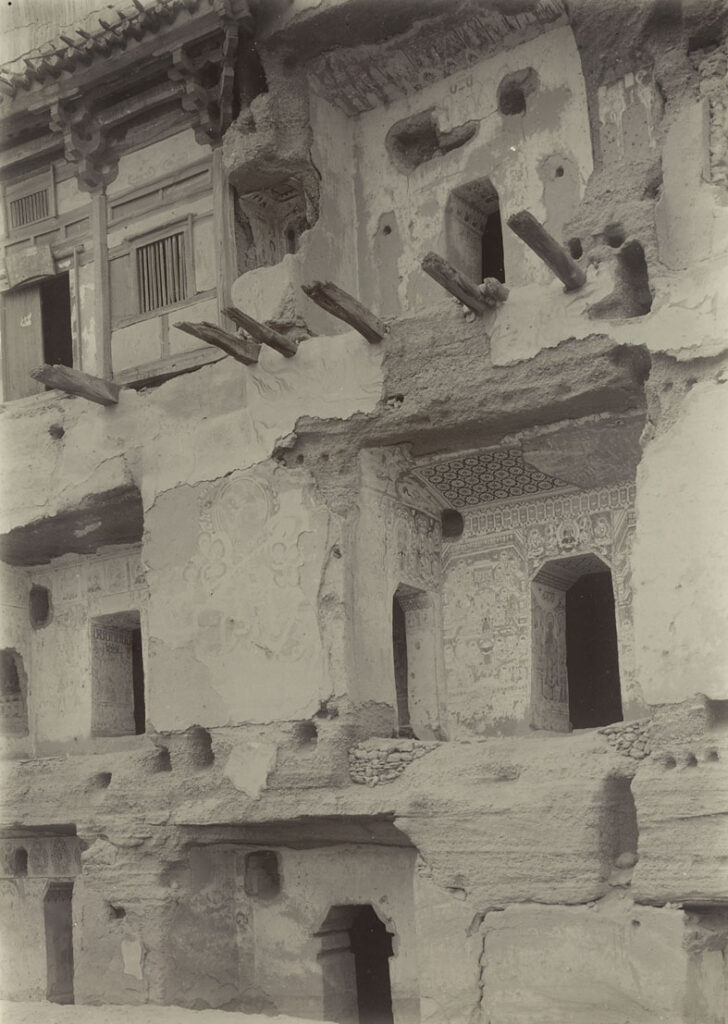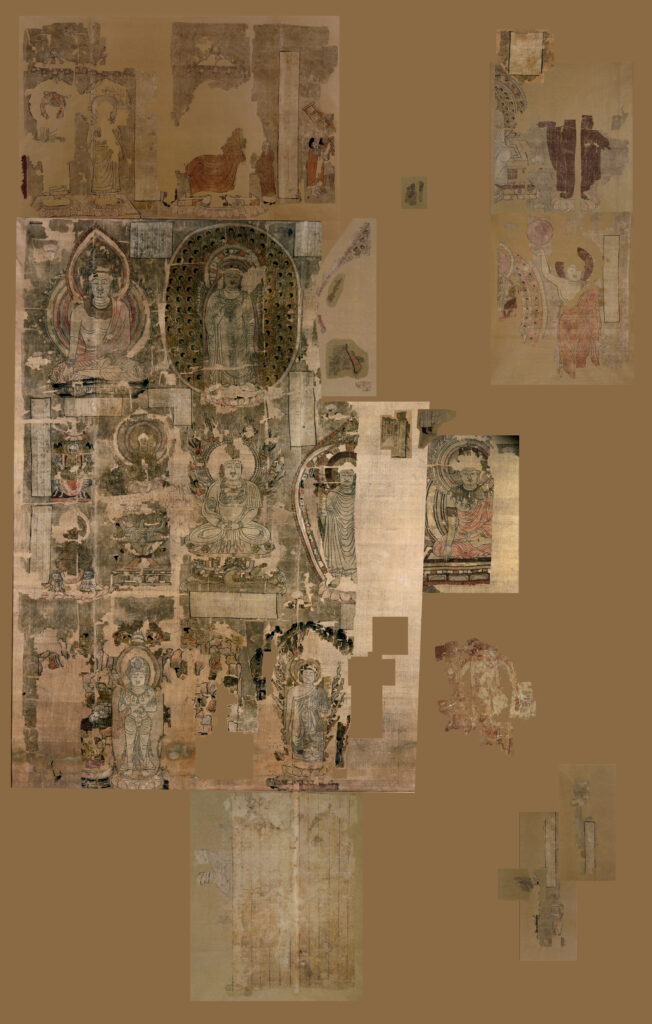Buddhism on the ground
Buddhist Caves: Dunhuang
In Buddhism, the tradition of building temples in caves is common and can be seen across Asia. Buddhist monks carved these caves directly into cliff faces, and used them as quiet spaces to practice meditation and Buddhist worship. They also housed exquisite works of devotional Buddhist art, including colourful murals, and huge sculptures carved into the cave walls.
The practice originated in India, but eventually hundreds of caves emerged along the Silk Roads and in China. One of the major cave complexes on the Silk Roads was the Mogao Grottoes in Dunhuang.
The Mogao Caves in Dunhuang
The first cave temple in Dunhuang appeared in 366 CE. Legend tells of a Buddhist monk named Le Zun, who stopped on his journey to rest at the Great Spring Valley near Dunhuang. Whilst watching the sunset over the Sanwei Mountain, he was amazed to see a vision of a thousand golden Buddhas, surrounded by golden light. This apparition inspired him to stop his journey and build a cave in which he could meditate and pay homage to the Buddha. Le Zun cut his cave by hand into the cliff-face opposite the mountain, and painted his vision onto the cave walls.
Pledge for the upkeep of the Mogao Caves
The caves at Dunhuang were busy working shrines. The visitors, the smoke and deposits from the incense and lamp oil, and the effects of the scouring sand all took its toll on the paintings and sculptures. Donors were not only required for the building and decorating of the caves, but also for their upkeep.
This document is a pledge made by sixteen men, dated 25th March 970, to make themselves responsible for ‘the upkeep of the cave temples in the valley of the Dang River’, that is, the Dunhuang caves. The pledge ends: ‘Even if Heaven and Earth collapse, this vow shall remain unshaken.’
Le Zun’s cave was soon followed by that of a second monk, Fa Liang, who adorned his niche with images to focus his meditation. Their work inspired other Buddhists in Dunhuang to show their devotion and carve their own caves.
Between the 4th and 14th centuries, hundreds of ornately decorated cave temples emerged in Dunhuang. These have come to be known as the Mogao Grottoes. For centuries, Dunhuang was a hub for Buddhist practice as well as commercial and cultural exchange between Silk Road travellers. This activity continued until around the 15th century. Since then, most of the caves were abandoned and fell into disuse until the early 20th century.
Dunhuang today
Photograph of the Mogao Caves at Dunhuang
This is a photograph of the Mogao Caves, a complex of nearly 500 monastic caves in Dunhuang, Gansu Province. Sir Marc Aurel Stein, a Hungarian-born British archaeologist, took the photograph in 1914 during his third expedition to the Mogao site.
The Mogao Caves, meaning ‘peerless caves’, were carved directly into cliff faces by Buddhist monks and were used as quiet spaces for worship and meditation. Hundreds of caves were excavated between the fourth and fourteenth centuries CE. Dunhuang, an oases city at the intersection of the ancient Silk Roads, became a pilgrimage spot and a hub of Buddhist practice. Today, the caves contain some of the best surviving examples of ancient Buddhist art, including wall murals, portable paintings, sculptures carved directly into the walls, textiles, and various devotional objects. One cave, known as Cave 17, was filled with manuscripts and sealed around 1000 CE. Its rediscovery in 1900 revealed an unrivalled source for knowledge of official and religious life in Dunhuang.
Today, there are nearly 500 surviving cave temples at Dunhuang. These caves were built between the 5th and 14th centuries CE. Some of the smallest caves are tiny niches; others are vast chambers that contain Buddhist figures over 30 metres high. Altogether, Mogao cave complex contains over 45,000 square metres of paintings and 2400 sculptures. One cave in particular, named Cave 17 or the ‘Library cave’, has revealed much about Dunhuang’s history.
Around 1900, a Daoist priest known as Wang Yuanlu took responsibility for restoring the Mogao caves. He came across a small sealed cave, and upon opening it up, discovered tens of thousands of hidden manuscripts and paintings. No one is sure why these items were hidden in Cave 17, but it was clear that they had been untouched for almost 1000 years. Many of the manuscripts were Buddhist texts, whilst others related to daily and official life on the Silk Roads. Explorers of the early 1900s purchased many of these items and brought them back to their own countries. They are now dispersed in museums around the world.
Virtual reconstruction of the Famous Images of the Buddha
After the Mogao caves came to international attention in the early 1990s, explorers and archaeologists of various nationalities acquired many of the items found there. These were dispersed across the globe and are now held in various collections. This painting, Famous Images of the Buddha, was found in Cave 17 in an extremely fragmentary state. Parts of it are now found in both the British Museum and the National Museum, New Delhi.
Here, these separated fragments have been brought together in a virtual reconstruction of the full-size painting. It features various depictions of the Buddha and bodhisattvas, and it relays some Buddhist stories. The virtual reconstruction is the work of Professor Roderick Whitfield after many years of research into both collections.


